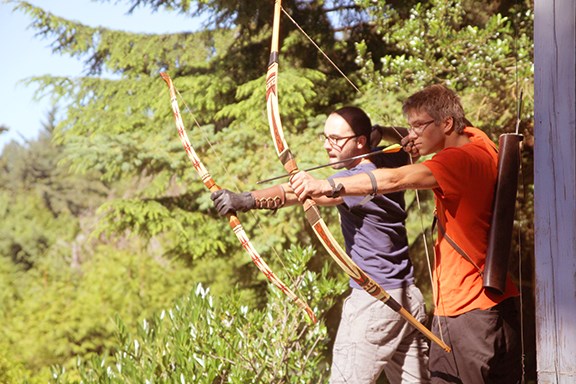Curiosity and experimentation have brought 22-year-old Teo Ploias a summer job that includes sourcing stone and wood, and target shooting.
The job is the making and selling of bows arrows that not only shoot, but are historically accurate.
Ploias and his cousin Robert Torok Szasz have been selling bows and arrows for roughly six months. Their company, Bowen Bows, operates out of a corner of Ploias’s father’s basement workshop in Bluewater.
As a kid, Ploias says he had a bow but not a very good one. Szasz says he always wanted a bow, but never had one until his cousin taught him how to make one.
Ploias made his first bow last summer.
“I was down at the beach with some friends and decided to make one just for fun,” he says. “I finished it and it looked quite beautiful, but it didn’t shoot that well. I figured if I did some research and put some time into it, I could actually make something really good.”
Ploias delved into his history books to find the specifics of various kinds of bows made in various periods and places, and how to best recreate them.
The Neolithic Holmegaard bow, discovered in the Holmegaard bogs of Denmark, is wide-limbed, a powerful shot, and originally made form elm.
The Bowen Bows version is made with rock maple and covered in rawhide.
Ploias has also crafted short re-curved bows that would have been used by the Mongols riding on horseback.
To learn to shoot and test the effectiveness of the bow, Ploias shot out of the back of a dinghy while his father drove it.
On his back deck, Ploias is storing a large piece of yew that he plans on making an English bow with.
“I think there might be two yew trees on Bowen,” says Ploias. “This is from one of them.”
Seventeen-year-old Szasz has gravitated towards the making of arrows (“fletching”). To make the shafts he uses arrowwood (otherwise known as oceanspray) collected locally, straightened over a fire or candle.
For an arrow based on those that would have been made in the Stone Ages, he is waiting for a friend to bring a chunk of obsidian from Oregon.
He’s also used chunks of random deer bone, found around Bowen, for arrowheads. As well as shale from a quarry in Jervis inlet which, says Ploias, hasn’t been used for this purpose for probably 300 years.
In six months, Ploias and Szasz say they have sold 10 bows, and right now, they have more orders than they can keep up with.
They say there are no particular long-term plans for Bowen Bows, but they are enjoying the process of learning their craft, and are open to where ever it might take them.



